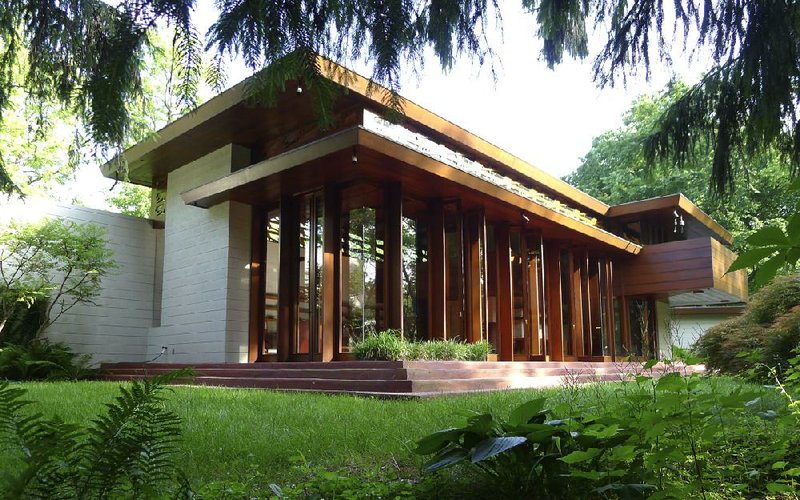Correction: Lawrence and Sharon Tarantino of New Jersey sold their Frank Lloyd Wright-designed Bachman Wilson House to Crystal Bridges Museum of American Art. The transaction was inaccurately described as a donation in a March 17 article in the Arkansas Democrat-Gazette. In addition, Tarantino Studio should have received credit for photos of the house published Jan. 16, Jan. 26 and March 17.
BENTONVILLE - “Usonian” was the label that iconic American architect Frank Lloyd Wright gave the distinctive type of American architecture that would become a precursor to today’s ranchstyle home.
He designed only 60 of these structures, one of which, the Bachman Wilson House, has been acquired by the Crystal Bridges Museum of American Art and is being moved from its site in Somerset County, N.J., to the Bentonville museum’s 120-acre grounds.
The Usonian label was coined by early 20th-century writer James Duff Law and later adopted by Wright.
In a 1903 miscellaneous collection of writings titled Here and There in Two Hemispheres, Law quoted a letter he wrote that year that begins “We of the United States, in justice to Canadians and Mexicans, have no right to use the title ‘Americans’ when referring to matters pertaining exclusively to ourselves.”
Instead, U.S. citizens should be called “Usonans” or “Usonians,” which was derived from an abbreviation of “United States of North America,” Law noted.
Two Wright scholars say the Bachman Wilson House and others like it are important in terms of defining Wright’s career, even if they’re not as notable as some of his other, well-known works such as Fallingwater in Mill Run, Pa., the Solomon R. Guggenheim Museum in New York City or even his own sprawling Taliesin Westhome in Spring Green, Wis.
“So many people are familiar with the arguably grander houses of Wright - buildings that are now accessible as house museums,” said Ethel Goodstein-Murphree, interim dean of the Fay Jones School of Architecture at the University of Arkansas at Faeytteville.
The late Fay Jones was an apprentice of Wright and a UA architecture professor and dean whose designs reflected the principles of Wright’s work.
“We tend to associate them - as we often do with architect-designed houses today - with them being more luxurious, being extraordinary,” Goodstein-Murphree added.
But Wright always thought about and proposed houses that were for the middle class,she said.
His Usonian homes were small in number, but their influence was far-reaching, said Anthony Alofsin, an architect, professor of architecture at the University of Texas at Austin and one of the world’s leading experts on Wright’s work. He’s written 12 books on the architect and his work.
Wright designed Usonian homes to be economical and convenient - “fitting the lifestyle that evolved in America at the time,” Alofsin said. The first Usonian home was constructed in 1936, though Wright is believed to have developed the idea at least a decade before.
New Jersey architect Lawrence Tarantino is overseeing its disassembly in Millstone and has described Usonian as “one of the purest designs of this period - a work of art in simplicity and form, unencumbered by programmatic constraints.”
The Wright-designed Bachman Wilson House, considered a classic Usonian-style dwelling, was built by Abraham Wilson and his first wife, Gloria Bachman. Her brother studied with Wright at Taliesin West, Wright’s home and studio in Scottsdale, Ariz. Construction of the house was completed in 1956.
Construction crews and preservationists are fighting the elements and time to disassemble the Bachman Wilson House near the Millstone River in New Jersey and prepare it for transport by truck and rail to Crystal Bridges. Work on the Crystal Bridges site has not yet started, saidDiane Carroll, interim director of communications at the museum.
In his Usonian designs, Wright replaced the kitchen with what he called “a work space.” He added a carport as more people came to own cars, and he integrated heating into the floor of the home, usually in the form of cast concrete called magnesite. The houses were mostly modular, which allowed flexibility in design, and many featured flat roofs, floor-to-ceiling windows and built-in seating and tables - all at an affordable price.
“They were a continuation of his long-held interest in creating models for mass-use and middle-class housing,” Alofsin said.
Even after Wright’s death at 91 in 1959, his Usonian influence on midcentury domestic architecture remained relevant because many young architects of the time were fluent in Wright’s work, he said. Even though the 60 or so Usonian dwellings were but a thin slice in Wright’s 1,000-plus item body of work, they were widely publicized.
In 1953, an exhibition titled “Sixty Years of Living Architecture: The Work of Frank Lloyd Wright” opened in New York on the site where the Guggenheim would eventually rise. The exhibition featured two buildings designed by Wright: a temporary pavilion made of glass, fiberboard and pipe columns, and a 1,700-square-foot, fully furnished, two-bedroom, model Usonian house.
“These homes have a much larger impact as they’ve sort of percolated through consciousness and people’s awareness,” Alofsin said.
Correction: A previous version of this story misstated the how Crystal Bridges acquired the house. The error has been corrected.
Arkansas, Pages 8 on 03/17/2014
